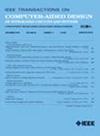Automated Design for Multiorgan-on-Chip Geometries
IF 2.9
3区 计算机科学
Q2 COMPUTER SCIENCE, HARDWARE & ARCHITECTURE
IEEE Transactions on Computer-Aided Design of Integrated Circuits and Systems
Pub Date : 2024-11-29
DOI:10.1109/TCAD.2024.3509795
引用次数: 0
Abstract
Multiorgans-on-chips (multi-OoCs) represent human or other animal physiology on a chip—providing testing platforms for the pharmaceutical, cosmetic, and chemical industries. They are composed of miniaturized organ tissues (so-called organ modules) that are connected via a microfluidic channel network and, by this, represent organ functionalities and their interactions on-chip. The design of these multi-OoC geometries, however, requires a sophisticated orchestration of numerous aspects, such as the size of organ modules, the required shear stress on membranes and subsequently the flow rate, the dimensions and geometry of channels, pump pressures, etc. Mastering all this constitutes a nontrivial design task for which, unfortunately, no automatic support exists yet. In this work, we propose a design automation solution for multi-OoC geometries. To this end, we review the respective design steps and derive a corresponding formal design specification from them. Based on that, we then propose an automatic design tool, which generates a design of the desired device and exports it in a fashion that is ready for subsequent simulation or fabrication. The open-source tool and a step-by-step tutorial are available at芯片上多器官几何图形的自动化设计
多器官芯片(multi- ooc)代表芯片上的人类或其他动物生理,为制药,化妆品和化学工业提供测试平台。它们由微型化的器官组织(所谓的器官模块)组成,这些组织通过微流体通道网络连接起来,通过这种方式,它们代表了器官功能及其在芯片上的相互作用。然而,这些多ooc几何形状的设计需要许多方面的复杂协调,例如器官模块的大小、膜上所需的剪切应力以及随后的流速、通道的尺寸和几何形状、泵的压力等。掌握所有这些构成了一项重要的设计任务,不幸的是,目前还没有自动支持。在这项工作中,我们提出了一个多ooc几何的设计自动化解决方案。为此,我们回顾了各自的设计步骤,并从中得出相应的正式设计规范。在此基础上,我们提出了一个自动设计工具,它生成所需设备的设计,并以一种为后续模拟或制造做好准备的方式将其导出。该开源工具和分步教程可在https://github.com/cda-tum/mmft-ooc-designer上获得。评估(受到现实世界用例的启发,并得到计算流体动力学模拟和制造过程的证实)证明了所提出方法的适用性和有效性。
本文章由计算机程序翻译,如有差异,请以英文原文为准。
求助全文
约1分钟内获得全文
求助全文
来源期刊
CiteScore
5.60
自引率
13.80%
发文量
500
审稿时长
7 months
期刊介绍:
The purpose of this Transactions is to publish papers of interest to individuals in the area of computer-aided design of integrated circuits and systems composed of analog, digital, mixed-signal, optical, or microwave components. The aids include methods, models, algorithms, and man-machine interfaces for system-level, physical and logical design including: planning, synthesis, partitioning, modeling, simulation, layout, verification, testing, hardware-software co-design and documentation of integrated circuit and system designs of all complexities. Design tools and techniques for evaluating and designing integrated circuits and systems for metrics such as performance, power, reliability, testability, and security are a focus.

 求助内容:
求助内容: 应助结果提醒方式:
应助结果提醒方式:


